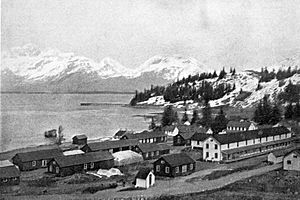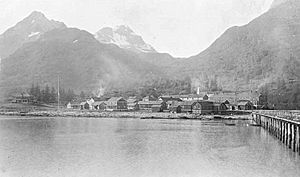Fort Liscum facts for kids
Fort Liscum was an important U.S. Army base in Alaska. It was located on the south side of Valdez Bay, across from where the city of Valdez is today. This fort was open from 1900 to 1922.
Contents
A Military Base in Alaska
In 1899, an Army officer named Captain William R. Abercrombie chose the spot for a new military base. This area, called Port Valdez, was the starting point for the Valdez-Eagle Trail. This trail led to another fort, Fort Egbert, near Eagle, Alaska.
Captain Abercrombie picked a spot with deep water for ships and a nearby stream for fresh water. He also wanted the fort to be far enough from town. This was so soldiers would not be influenced by the "whisky element" found in frontier towns. The original town of Valdez was busy with gold prospectors. Many people were heading to the Klondike gold fields.
Building the Fort
In May 1900, about 100 soldiers arrived to build the new base. They built 37 buildings. These included homes for officers, a hospital, a stable, and a bakery. A report from the U.S. War Department said the fort was well-built. However, it noted that the location was "unfortunate." The mountains around it blocked the sun. This meant that winter snow would not melt until June.
On September 6, 1900, the base was named Fort Liscum. It was named after Colonel Emerson H. Liscum. He had died in Tianjin, China in July 1900. Colonel Liscum was leading the U.S. Army's 9th Infantry Regiment. They were part of a group of countries trying to stop the Boxer Rebellion. Later, the 9th Infantry Regiment was stationed at Fort Liscum.
Connecting and Helping
On August 24, 1902, Fort Liscum was connected by telegraph. This was part of the Washington-Alaska Military Cable and Telegraph System (WAMCATS). It linked Fort Liscum with Fort Egbert.
In 1914, soldiers from Fort Liscum helped the town of Valdez. Valdez often flooded because of melting ice from the Valdez Glacier. The soldiers helped build a wall, called a dike, to protect the town from these floods.
Closing the Fort
Fort Liscum closed in 1922. Many military bases were closed after World War I. After the Army left, the number of people living in Valdez dropped. It had been 7,000 during the gold rush. After the fort closed, it fell to fewer than 500 people.
What Happened Next
In 1925, the land was given to the U.S. Dept. of the Interior. They sold some of the buildings, which were moved. In 1929, a family named Andrew and Oma Belle Day claimed the land. They called it Dayville and opened a cannery and a sawmill there.
Much later, the Trans-Alaska Pipeline was built. Its marine terminal, which opened in 1977, is on the same land that was once Fort Liscum. Today, a field gun from Fort Liscum is on display at the Valdez Museum.



